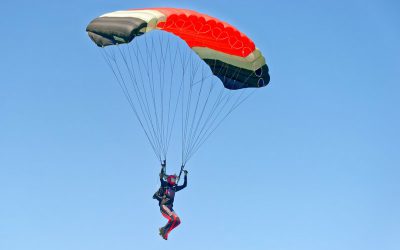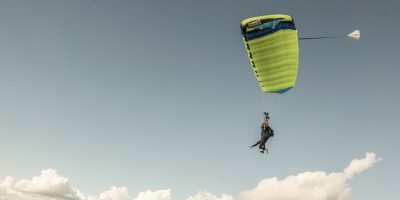To the untrained eye, parachutes are a little mysterious — which naturally breeds curiosity. People often don’t realize that there are actually multiple different parachute types that range from ram-air parachutes to rogallo wings. And, of course, the famous and historical round parachutes of old. First things first – we need to address the way skydivers talk about their parachutes. In skydiving, we don’t tend to call our parachutes “parachutes.” Instead, we call them “canopies” or “wings.”
 In general terms, we have several choices when it comes to parachute shapes (AKA types of parachute canopies): rectangular, tapered, elliptical, and semi-elliptical. These terms refer to the shape of the canopy when viewed from overhead. The shape of the canopy, as well as its size, greatly affects the flight characteristics of the said canopy. In other words: these factors determine how a jumper can expect their canopy to open, fly, and land. And also what style of flight the canopy is used for!
In general terms, we have several choices when it comes to parachute shapes (AKA types of parachute canopies): rectangular, tapered, elliptical, and semi-elliptical. These terms refer to the shape of the canopy when viewed from overhead. The shape of the canopy, as well as its size, greatly affects the flight characteristics of the said canopy. In other words: these factors determine how a jumper can expect their canopy to open, fly, and land. And also what style of flight the canopy is used for!
So then, what type of parachute is most effective? Is a circular parachute or a rectangular parachute better? Let’s address these questions and more as we go over the different kinds of parachutes available in the world of air sports.
Different Parachute Types
Canopies come in a variety of shapes and sizes so that skydivers (and other air sports enthusiasts) will have options depending on skill level, desired flight characteristics, and personal preference.
Here’s a list of some of the main kinds of parachutes and what they’re used for:
Ram-Air Parachutes
The ram-air design is the most popular parachute shape in modern skydiving. These parachutes are rectangular and look and function the same as an airplane wing. The front of a ram-air parachute has open holes that allow the canopy to inflate and become rigid like a wing. From there, the parachute generates lift and allows the skydiver to fly extremely accurate and controlled paths through the sky.
Round Parachutes
Round or circular parachutes are what many people picture when they think of skydiving even though they’re rarely used anymore. Round parachutes are shaped exactly as they sound – round – and resemble giant, flying jellyfish when they are open in the sky. What are round parachutes used for? In the early years of skydiving, round parachutes were used for everything. Nowadays, they’re mostly used by the military because of their simple design and ability to carry heavy loads. Sometimes you might catch a glimpse of a civilian skydiver using a round parachute as a sort of throwback exhibition! Important note: these parachutes aren’t steerable!
Cruciform Parachutes
These bad boys are the modern iteration of a round parachute. The cruciform parachute corners have been slightly squared off, resulting in a sort of marshmallow look bobbing around in the sky. This advancement reduces oscillation and makes landings about 25% softer than those of traditional round parachutes. This is another parachute that is almost exclusively used by the military because of its specific abilities.
Rogallo Wings
The rogallo wing type of parachute is a triangular parachute that you won’t see being used on a skydive anytime soon. Rogallo wings are most often used in fixed-wing situations like spacecraft, ultralight aircraft, and kites. They are also used in paragliding and hang gliding, sometimes as an emergency backup.
Understanding Parachute Sizes
 It’s not just a canopy’s shape that defines how it flies. Two parachutes of the same shape but different sizes could fly in vastly different ways. When we talk about size, we’re not just talking about the literal square footage of the parachute (though that does come into play when determining how it will fly). We’re more specifically referring to wing loading: the ratio of the body weight of the jumper to the size of the canopy. That number is what determines the canopy’s speed in flight.
It’s not just a canopy’s shape that defines how it flies. Two parachutes of the same shape but different sizes could fly in vastly different ways. When we talk about size, we’re not just talking about the literal square footage of the parachute (though that does come into play when determining how it will fly). We’re more specifically referring to wing loading: the ratio of the body weight of the jumper to the size of the canopy. That number is what determines the canopy’s speed in flight.
For example: a 150 square-foot canopy is going to fly a lot faster when the person wearing it weighs 200 lbs than when the wearer is 130 lbs. It’s science!
One might think that there’s a “magic number” that determines the optimal wing loading for every canopy in the world, that each canopy size and shape would fly best when a person of a certain weight flies it. But that’s not the case. Manufacturers give their very best recommendations on wing loading charts, but everyone agrees that the best wing loading for each jumper is one that feels safe, comfortable, and supportive of his or her particular preferences, skill level, and conditions.
For this reason, skydivers often test jump canopies before they buy them – in quite the same way as you test drive a car. Even if the wing loading is perfect on paper, it just might not feel right. There’s also extensive guidance around what shape and size parachutes are suitable for skydivers of different skill levels. Experienced jumpers and instructors are always happy to help advise on what canopy a newer jumper should fly.
At the end of the day, after all, it’s the feeling right and flying safely that counts. Rectangular, round, big, small, floaty, accurate … none of this stuff makes a canopy “good” or “bad.” Parachutes come in different shapes and sizes, just like people. The proof of a “good parachute” is in the jumper who flies it!
Come check out what it feels like to fly a parachute at Skydive Monroe! Blue skies!
Copyright © 2025, Skydive Monroe, All Rights Reserved.
DropZone Web Design & Marketing by Beyond Marketing, LLC



